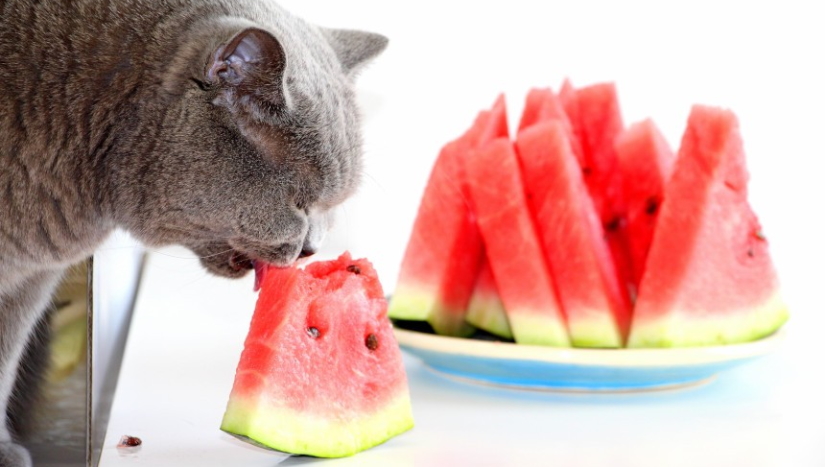Watermelon is a healthy and delicious summertime treat that many people love. If your pets start begging for a bite as you enjoy this sweet snack, you may wish to share a small piece with them. Dogs can eat watermelon, so it’s okay if your pooch snags a chunk of this fruit off the counter. But, what about your feline friends? Can cats eat watermelon too?
What Happens If My Cat Eats Watermelon?
According to the ASPCA, the watermelon plant is non-toxic to cats. Even so, eating certain parts of a watermelon can have adverse effects on your feline friends. While the flesh of the melon is safe in small doses, an entire meal of watermelon can cause stomach aches. Also, the rinds and seeds can prove difficult for cats to digest
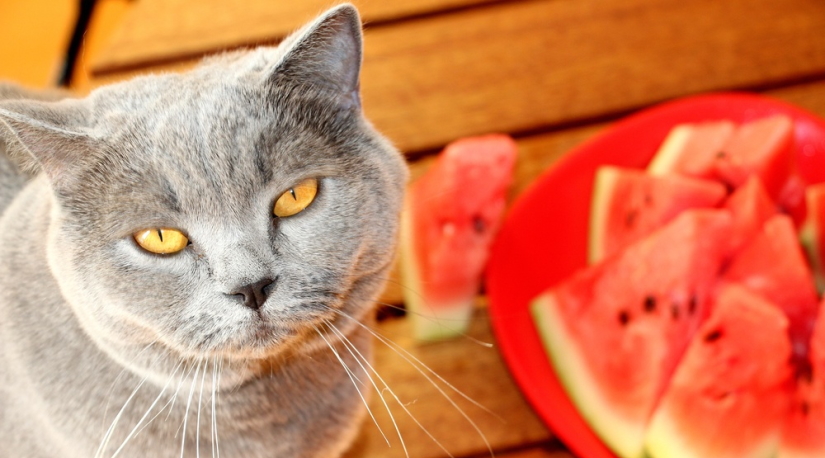
Safest Way for Cats to Eat Watermelon
If you plan to treat your cat to a small taste of watermelon, be sure to choose a seedless melon or remove all the seeds from the fruit yourself first. Since this fruit is not a part of a feline’s natural diet, watermelon should only be an occasional treat. Only give your cat a thin slice or a little ball of melon to help your pet avoid digestive issues and stomach pain.
How Much Watermelon Can a Cat Eat?
Depending on your cat’s nutritional needs, they may need a specific amount of this hydrating treat to avoid disrupting their diet. If you’re looking for a more accurate measurement than “a small amount of watermelon,” take the following steps to determine the exact amount of watermelon that’s safe for your cat:
- Ask the Vet – Some pets have allergies, diabetes, or other dietary restrictions that make fruits an unhealthy option. Ask a veterinarian or vet tech if watermelon would be a safe treat for your cat.
- Calculate Calories – Overall, treats should account for roughly 10% of a cat’s daily caloric intake. Although watermelon is a low-calorie treat with only 45 calories per cup, each cat’s nutritional needs differ depending on their age, weight, and activity level. Check with your vet to see if you should put your cat on a diet and to learn how much watermelon you can feed your feline.
- Start Small – After you talk with a vet about whether watermelon would be a healthy treat for your cat, slowly begin integrating the fruit into their diet. Wash the melon, then cut away the rind and removed the seeds before dicing it into tiny kibble-sized pieces. From there, you can feed the fruit to your cat little by little.
- Monitor Your Pet – Even a non-toxic food like watermelon can cause some harmful reactions for your pet. Keep an eye on your cat while they enjoy this treat to ensure they don’t choke on a missed seed. You should also monitor your cat’s behavior once they finish the watermelon in case of vomiting. If your cat starts showing signs of stomach upset, call your veterinarian.
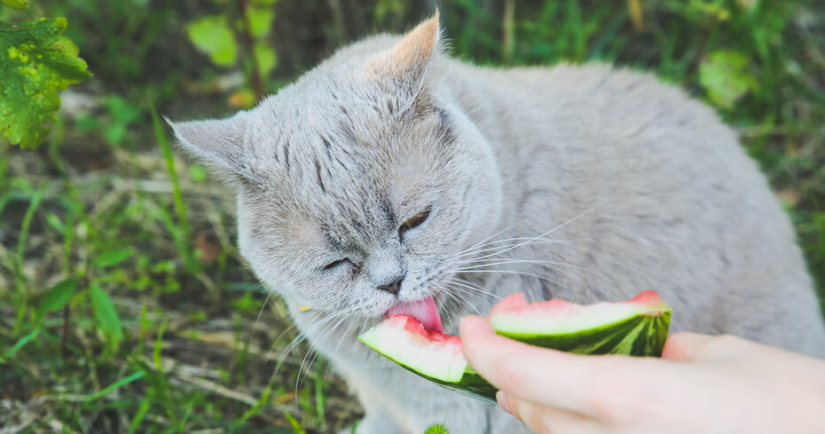
Can a Kitten Eat Watermelon?
Just like fully-grown cats, kittens can eat watermelon. However, since kittens are still growing, you’ll need to take a few extra precautions. Watermelon has a high sugar content that may not be ideal for a kitten’s digestive system, so you’ll need to give them an even smaller portion than you would give an adult cat. Let your kitten try a tiny piece of watermelon, then switch back to other kitten treats.
Seeds, Skins and Pits of Fruits
Even if the flesh of a fruit is safe for pets, other parts of these foods may be toxic to cats and dogs. For example, apple seeds contain harmful amounts of cyanide that can be lethal to small animals, as do the pits from apricots, peaches, plums, and cherries. To protect your pet from these harmful effects, you should always remove the following segments before feeding fruit to your cat:
- Seeds and pips
- Stems
- Skins (except apples)
- Peels
- Rinds
- Pits
- Cores
- Leaves
Do Cats Benefit from Fruit?
Fruit can sometimes be a healthy substitute for some traditional cat treats. Still, it’s important to keep it as an occasional treat and stick to your cat’s regular foods most of the time. According to Animal Trust vets,
“Cat’s must always get the bulk of their nutrition from commercial pet food as they have very particular requirements; protein deficiency, in particular, can cause severe problems in cats.”
While fruit offers tons of nutrients for humans, a cat’s diet doesn’t require fruit. An article by the ASPCA states that cats are obligate carnivores, which means that they need to eat meat to survive. Usually, the amount of fruit that is safe for cats is too small to bring any benefits. However, fruits like watermelon have water and fiber that can hydrate your cat and help with digestion.
Fruits as Treats for Cats
Every cat has its own, unique tastes when it comes to food and treats. Some felines may think watermelon is a delicious snack, while cats who are picky eaters might not enjoy the fruit at all. Since cats cannot taste sweet flavors, there’s no telling whether your cat will appreciate fruits the same way you might.
Despite your cat’s inability to taste sweetness, fruit can still be a refreshing treat for your feline friend. Some fruits are safe for your pets, while others can be toxic. Knowing which fruits are safe for cats and which ones can make them ill is essential when it comes to keeping your furry friend happy and healthy.
Safe Fruits for Cats (In Moderation)
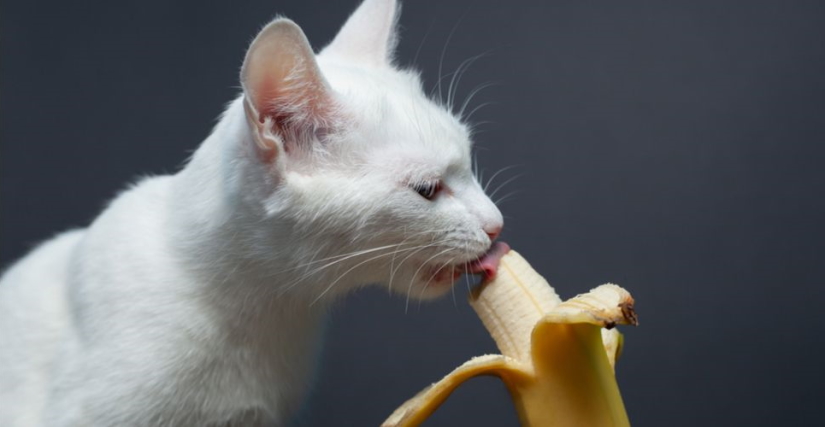
The following fruits are safe for your cats in small quantities, so there’s no need to worry if your pet picks up a piece from the floor or the countertop. However, only certain parts of these fruits are okay for your cat to eat. Discard the peels, pits, cores, rinds, seeds, skins, and stems of these fruits before letting your cat snack on them:
- Bananas: Whether you have a kitten or are taking care of an older cat, bananas are a safe and healthy snack for your feline friend. This soft fruit can be a source of potassium and vitamins B6 and C for your pet. Even frozen bananas can be a cool and natural treat. Bananas do have a high sugar content though, so be sure only to offer a piece or two occasionally.
- Berries: Strawberries, blueberries, blackberries, and raspberries are low in sugar yet high in antioxidants and fiber. While these fruits aren’t cat multivitamins, your pet may still want to take a bite. Before serving berries to your cat, be sure to wash them, remove the stems and leaves, and cut them into bite-size pieces to prevent your pet from choking.
- Melons: Just like watermelon, cantaloupe and honeydew are low-calorie fruits that cats can eat. Cantaloupe, in particular, gives off a scent that mimics the smell of meat proteins, so your little carnivore will most likely love it. Remember to discard the rind and only treat your cat to small pieces of the fruit’s flesh.
- Apples: Cats receive many of the same health benefits from apples that humans do. The flesh is high in calcium, Vitamin C, and Vitamin K. Apple skins are full of nutrients as well. While you should still remove the stems, cores, and seeds, the peel and tiny cubes of fruit flesh are safe for cats.
- Mangoes: Once you remove the skin and seed, mangoes can be a good snack for cats. This sweet fruit is rich in fiber as well as vitamins A, B6, and C. Although it’s okay to give your cat small pieces of mango flesh, treating them with too much mango could result in frequent trips to the litter box.
- Pineapple: While fresh pineapple is okay for cats to ingest, canned pineapple has syrups and preservatives that can upset your pet’s stomach. The high amount of fructose in this tropical fruit is not part of a cat’s diet. However, small amounts are usually safe. Remove the leaves, thorns, and rind completely before letting your cat have a taste of pineapple.
- Peaches: Fresh peaches are another safe fruit for cats to eat. Peaches have a healthy amount of Vitamin A, which provides extra support for your pet’s immune system. Be sure to remove the toxic pit and cut the peach into bite-sized pieces before giving this fruit to your cat.
- Pears: After you remove the seeds and core and cut the flesh into chunks, a fresh pear is a decent treat for your feline friends. Along with its high fiber content, pears are soft enough for older cats with dental problems to snack on. Only feed a cat two or three pieces of the pear’s flesh to keep their sugar intake under control.
Fruits Cats Can NOT Eat
Fortunately, the list of toxic fruits for cats is shorter than the list of fruits they can eat. However, the side effects of eating one of the more toxic foods for pets can be serious or even life-threatening. If you believe your cat consumed one of these toxic fruits, notify your vet immediately for instruction or call the Pet Poison Helpline for assistance:
- Grapes and Raisins: Grapes are toxic to both cats and dogs. Certain toxins in these fruits can cause acute kidney failure along with vomiting, diarrhea, lethargy, and other digestive issues. As such, you should avoid treating your cat with grapes or raisins.
- Citrus Fruit: Limes, lemons, oranges, and grapefruits contain different amounts of citric acid and essential oils in their stems, leaves, peels, flesh, and seeds. Large amounts of these fruits can cause irritation and issues with your cat’s central nervous system. Even a small amount of citrus fruit can upset your pet’s stomach.
- Fruit Snacks: Just in case your toddler decides to share a fruit snack with the family cat, it’s good to know about the effects these treats can have on your pets. Although it’s unlikely your cat will experience any serious reactions, fruit snacks have too much sugar for a feline’s diet. They may cause stomach upset and vomiting if your cat eats them.
Steps to Take If Your Cat Eats Toxic Fruit
If you suspect your cat has eaten one of these toxic fruits, there are a few steps you can and must take to prevent an adverse reaction. Ingestion of toxic foods is not an uncommon event for veterinarians to see, but it’s still crucial your pet gets help as soon as possible. Think your cat got into something toxic? Here is what to do:
- Determine the cause. Try to find out what toxic food your cat ate and how much of it they ingested. Having this information on hand can be extremely helpful when talking to vets and poison control.
- Contact the vet immediately. During open hours, your vet should be able to instruct you on how to induce vomiting if your cat swallows toxic food. In other cases, they may insist that you bring your pet to the veterinary clinic right away. You can also take your cat to an emergency vet after hours. Never induce vomiting without your vet’s approval.
- Call a Poison Control Hotline. Whether it’s the ASPCA poison control hotline or another emergency organization, experts on these helplines provide instructions on what to do next. There is a fee for the assistance, but the advice is worth it, especially if you do not have a veterinarian’s office close by.
Side Effects of Eating Toxic Fruit
Fruits that contain unsafe levels of essential oils, cyanogenic glycosides, and citric acid can cause a variety of harmful side effects for your cat. Some may even prove lethal if ingested in a large enough amount. Unfortunately, any amount may be unsafe so it’s best to contact your vet as soon as possible. Some warning signs that your cat has eaten a toxic fruit may include:
- Vomiting
- Diarrhea
- Lethargy
- Depression
- Lack of appetite
How We Care Matters
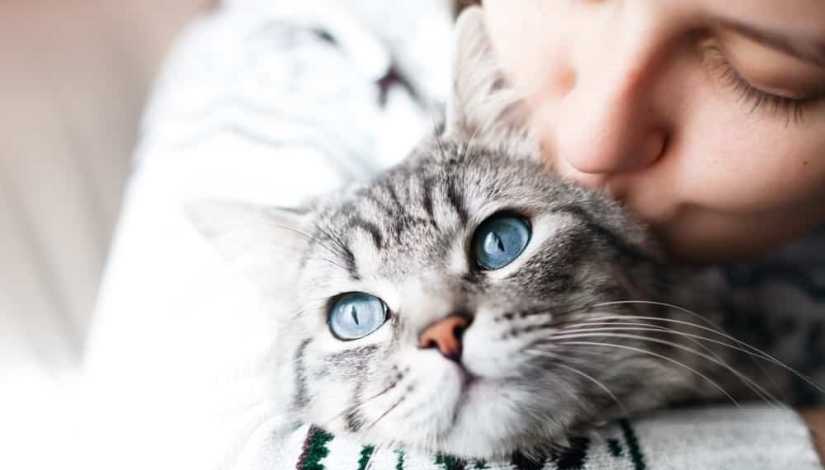
From designing a fun and cozy pet room for their furry friends to getting them top-rated litter boxes and toys, most animal lovers will do almost anything to keep their pets happy and healthy. One of the best ways to care for our pets is to feed them a diet of healthy foods, along with the occasional tasty treat.
